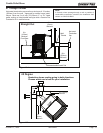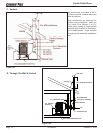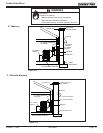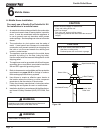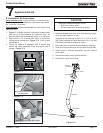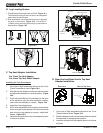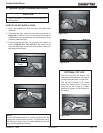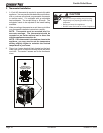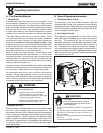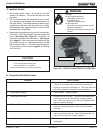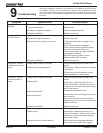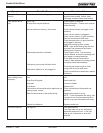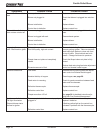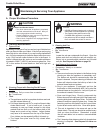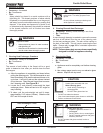
R
R
R
October 11,, 2005
250-6422D
Page 21
Castile Pellet Stove
8
Operating Instructions
A. Fuel Size And Material
1. Wood Pellets
Fuel pellets are made from sawdust or wood by-products. If the
source material is hardwood, they can have a higher mineral
content, creating more ash. Fuels containing bark will also have
higher ash content. Minerals and other noncombustible materials
such as sand will turn into a hard, glass-like substance called
a clinker when heated to the extreme temperatures our firepot
reaches. This is what forms clinkers in the bottom of the firepot.
Trees from different areas will vary in mineral content. That is
why some fuels produce more clinkers than others. Pellets are
manufactured in either 1/4 inch or 5/16 inch (6-8mm) diameter and
should be no more than 1-1/2 inches (38mm) in length. Pellet
lengths may even vary by lot from the same manufacturer which
is why the feed rate may need to be adjusted occasionally. If you
burn pellets longer than 1-1/2 inches (38mm) you may have an
inconsistent fuel feed rate and/or missed ignitions.
Pellet fuel quality can greatly fluctuate. We recommend using
premium grade fuel with ash content less than 1%. Even in some
fuel labeled “premium” ash content can vary from bag to bag and
possibly exceed 1%. High ash fuel, or lack of maintenance, can
cause the firepot to fill up and thus create a potential for smoking,
sooting and possible hopper fires.
Always burn dry fuel. Burning fuel with high moisture content takes
heat from the fuel and tends to cool the appliance, robbing heat
from your home. Damp pellet fuel can clog the feed system.
We recommend that you buy fuel in multi-ton lots whenever
possible. Buying large quantities of fuel at once will greatly
reduce the number of times the feed adjustments will need to be
made. However, we do recommend trying various brands before
purchasing multi-ton lots to ensure your satisfaction.
2. Shelled Field Corn
Extensive factory and field testing has demonstrated shelled
field corn to be an efficient and very economical fuel. We
recommend the use of a 50-50 blend of corn and wood pellets.
The only change in operation is that the feed rate may require
a slight adjustment. The BTU output of the appliance varies
slightly compared to pellets, depending on the quality of the
corn used. In cases where it is acceptable for the appliance to
run full time, 100% corn will work after the fire has been started
using wood pellets.
B. General Operating Information
Figure 21.1
Fire Hazard.
Keep combustible materials, gasoline
and other flammable vapors and liquids
clear of appliance.
WARNING
• Do NOT store flammable materials in the appliance’s
vicinity.
• Do NOT use gasoline, lantern fuel, kerosene, charcoal
lighter fluid or similar liquids to start or “freshen up” a
fire in this heater.
• Keep all such liquids well away from the heater while
it is in use.
• Combustible materials may ignite.
1. Thermostat Calls For Heat
The appliance is like most modern furnaces; when the
thermostat calls for heat, your appliance will
automatically
light and deliver heat. When the room is up to temperature
and the thermostat is satisfied, the red call light will go off
and the appliance will shut down.
2. Heat Output Controls
This appliance is equipped with a heat output control
switch that has three settings or burn rates; low, medium
and high. The appliance will turn on and off as the
thermostat demands. When the thermostat calls for heat,
the appliance will start up at the burn rate for which it is
set. If the appliance is set at one of the lower settings, it
will run quieter but take longer to heat up an area than if it
were set at a higher burn rate. Regardless of the burn rate,
when the area is warm enough to satisfy the thermostat,
the appliance will shut off.
High
Med
Low
Heat Output Switch
Reset Button
Reset
Button
WARNING
Fire and Smoke Risk.
• High ash fuels or lack of maintenance
can cause firepot to overfill. Follow
proper shutdown procedure if ash buildup
exceeds haf way point in firepot.
• Failure to do so could result in smoking,
sooting and possible hopper fires.



